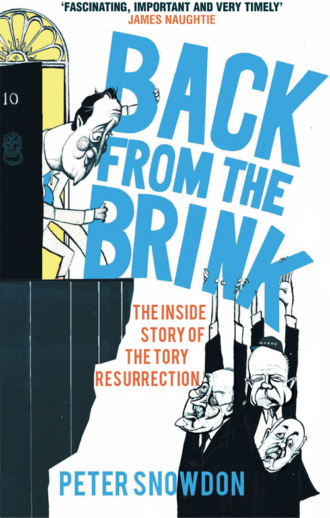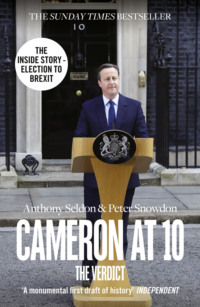
Полная версия
Back from the Brink: The Inside Story of the Tory Resurrection

PETER SNOWDON
Back from the Brink
The Inside Story of the Tory Resurrection

To Julia, with all my heart
CONTENTS
Cover
Title Page
Introduction
ONE: The Makings of a Landslide
TWO: Lost in the Wilderness May 1997–June 2001
THREE: Staring Into the Abyss June 2001–October 2003
FOUR: False Dawn November 2003–May 2005
FIVE: Signs of Life May–December 2005
SIX: Leaving the Comfort Zone December 2005–December 2006
SEVEN: The Great Escape January–October 2007
EIGHT: Riding High October 2007–September 2008
NINE: Crunch Time September 2008–April 2009
TEN: Aiming for the Summit May–December 2009
Sources
Bibliography
Index
Acknowledgements
About the Author
Copyright
About the Publisher
Introduction
‘We will be tested. I will be tested. I’m ready for that … So yes, there is a steep climb ahead. But I tell you this: the view from the summit will be worth it.’ David Cameron could not have chosen a more apt metaphor to describe the journey his party has to complete if it is to return to power. The scale of the task is formidable. Thirteen years ago, the British people ejected the Conservative Party from office in a landslide. So modest has the Conservative electoral recovery been since 1997 that the party Cameron leads into this year’s election is barely halfway up the mountain.
In order to win the general election with an overall majority of one, his party has to achieve something quite historic: it would have to win 117 seats, and a swing from Labour of 6.9 per cent. Not since 1931 has the party managed to make up so much ground in one election. The greatest swing the Tories have achieved since the Second World War is 5.2 per cent, in the election that brought Margaret Thatcher to power in 1979. Then, the Conservatives went into the election with 277 seats. Now the party has just under two hundred. David Cameron will have to emulate the success Tony Blair accomplished in 1997, transforming the electoral landscape of Britain in just one night. It is a very tall order, but for all the difficulties they face, under Cameron the Conservatives stand a far better chance of success than at any time since 1992 – the last time the party won a general election.
The thirteen years since Tony Blair’s 1997 landslide victory have been a chastening experience for a party that had become used to power. Before 1997, the Conservative Party’s dominance was such that the twentieth century became known as the ‘Conservative century’.1 The party was in office, either with a working majority or as the lead partner of a coalition, for two-thirds of the century. By contrast, Labour won power with a majority above single figures on just three occasions: 1945, 1966 and 1997. In most cases Labour governments were swiftly expelled from office by a resurgent Tory opposition. The party’s extraordinary success in recovering and holding on to power was due to its ability to adapt its policies and its appeal. More often than not, the Conservatives used their time in opposition wisely. The clearest example is after Labour’s landslide in 1945. Within six years the Conservatives were returned to office, having revitalised their organisation and conducted a wide-ranging review of policy. Although Winston Churchill retained his standing as a popular war leader, his party had become deeply unpopular and out of touch by the end of the Second World War. By learning the lessons of defeat after 1945, the party was able to move on and forge a new direction.
The defeat in 1997 left the Tories with fifty or so fewer seats than after the Labour landslide of 1945, but the subsequent period in the wilderness would be far less propitious. The roots of the party’s recent difficulties can be found in the Thatcher revolution. Mrs Thatcher and her government transformed British politics. The Conservatives’ electoral success in the 1980s was due in large part to her forceful and determined leadership. But when she began to lose touch with the country after her third successive election victory, it would not be long before many in the party turned on her. The Tories’ appeal to voters narrowed. They had become identified with the free market and individual freedom, but were perceived as being indifferent to social problems.
The bitterness that stemmed from the trauma of Mrs Thatcher’s downfall and the divisions that underpinned it would sap the party’s appetite for power in the 1990s. New Labour was born out of the rise and fall of Mrs Thatcher. Only by adapting to the Thatcher revolution did Labour find a way of becoming electable again. After eighteen long years in opposition it was desperate to win office, and as a result it embraced the formula that had sustained the Tories in government for so much of the twentieth century: adaptability and a hunger for power. The Conservative Party lost these qualities long before 1 May 1997.
In failing to adapt to the realities of the new political scene, the Conservatives dug themselves into an even deeper hole after the Labour landslide in 1997. Ignoring the public mood, they retreated to the margins of political debate, choosing a succession of unelectable leaders through a combination of bitter enmity and ideological fixation. So grave was the malaise that had taken hold of the party, and so weak was its leadership, that in the autumn of 2003 it teetered on the brink. The prospect of a third consecutive electoral defeat devastating the party was very real.
In their own peculiar ways, each of the three leaders between 1997 and 2005 – William Hague, Iain Duncan Smith and Michael Howard – attempted to broaden the party’s appeal in opposition. Why and how they failed forms the story of the first half of this book. While Howard was unable to attract greater support among the electorate, the party began to regain a sense of discipline and purpose after years of infighting and recrimination. But the personal feuds and ideological differences that had beset the parliamentary party since the early 1990s threatened to return with a vengeance after the defeat in May 2005. Annihilation had been averted, but the Tories had recovered little ground.
The emergence of a new generation of modernising Conservative politicians, led by David Cameron and George Osborne, untainted by the dying days of the last Tory government, is pivotal to this story. If the Conservative Party’s decline was shaped by the legacy of Margaret Thatcher, the twists and turns in its resurrection have been influenced by the other commanding figure in British politics of recent times: Tony Blair. By learning the lessons from New Labour’s electoral success under Blair, this new generation of modernising Tories have succeeded where their predecessors so visibly failed.
In December 2005, David Cameron achieved something few before him had ever accomplished. In just four and a half years he had gone from novice backbencher to Leader of the Opposition. He would have the same amount of time to pull the party back to the centre of British politics and reinvigorate it to the point of being a credible alternative government. It would be an audacious undertaking for a thirty-nine-year-old politician. The second half of Back from the Brink tells the story of how Cameron has sought to change his party. In essence, he has tried to heal old wounds and restore a sense of balance to Conservatism by reviving a concern for social reform.
Cameron’s project to modernise the party has given it a new lease of life, yet at times it has seemed perilously close to falling apart. There have been three moments when his leadership was under severe pressure: after Gordon Brown became Prime Minister in June 2007; in the immediate aftermath of the financial crisis in October 2008; and during the expenses crisis in May 2009. On each occasion, the Conservative Party’s recovery was at stake, as was Cameron’s authority as leader. The fact that the Cameron project was in peril on each occasion exposes the flaws in the party’s strategic direction, but at the same time it throws light on the tactical agility of its leadership in bouncing back.
David Cameron’s mission to revive the fortunes of the Conservative Party has encountered reversals, yet it remains intact. Whether voters believe that he and his party are ready to take on the responsibility of governing the country is still to be seen. In Gordon Brown, the Conservatives face a battle-hardened Prime Minister who has been at or near the summit of British politics for the best part of two decades, both in opposition and in government. Brown is a great survivor: he has seen off two plots from within his Cabinet to remove him in the last two years. For the man Cameron describes as ‘a steamroller who just keeps going’, the general election will be a hard-fought battle to the end.
Much is at stake for both the old warhorse and the young pretender of British politics. For Brown, leading Labour into a fourth term would represent the most impressive recovery by an incumbent government in modern history. For Cameron, forming a government would end the longest uninterrupted period in opposition his party has endured since 1832. A fourth successive election defeat, however narrow, would represent a massive failure for everything Cameron has sought to achieve in the past four years, and would reduce the party to a state of acrimony and division. If the Conservatives cannot win amidst the economic gloom that pervades the country in 2010, when can they?
Based on more than 120 interviews with figures from across the Conservative Party – from successive leaders to representatives of the grassroots – this book tells the story of how a once formidable fighting force in British politics stared into the abyss before making its way back to be in contention for power. By talking to a wide range of party insiders, both on and off the record, I hope to have built up a candid and unvarnished account that sheds new light on a dramatic tale of decline and renaissance.
The Conservative Party may have come back from the brink of disaster, but rediscovering its winning formula has been far from easy. As David Cameron and his party prepare for their steep climb to the summit in the months ahead, it would probably be best if they did not look down. Theirs has been a long, harsh and often painful journey. I hope that readers will find it a compelling one.
Peter Snowdon
December 2009
Конец ознакомительного фрагмента.
Текст предоставлен ООО «ЛитРес».
Прочитайте эту книгу целиком, купив полную легальную версию на ЛитРес.
Безопасно оплатить книгу можно банковской картой Visa, MasterCard, Maestro, со счета мобильного телефона, с платежного терминала, в салоне МТС или Связной, через PayPal, WebMoney, Яндекс.Деньги, QIWI Кошелек, бонусными картами или другим удобным Вам способом.



